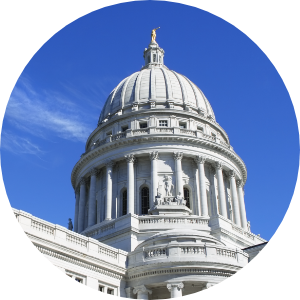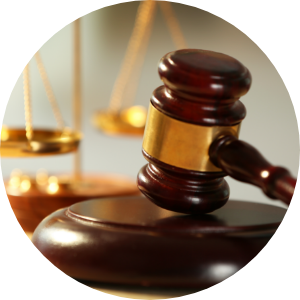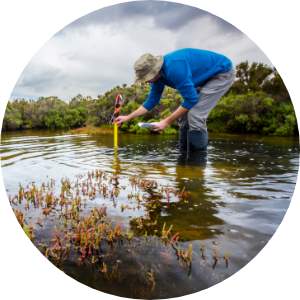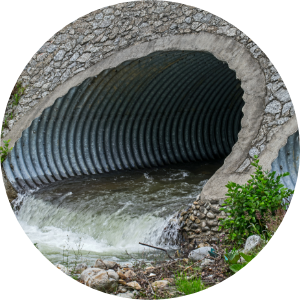Our Water > Wetlands
Safeguarding Our Wetlands
Nature’s protectors are now in need of protection. Wisconsin’s wetlands clean our water, prevent floods, store carbon, and support wildlife. But nearly half have been lost—and the rest remain under threat. Clean Wisconsin is working to protect what’s left and restore what we can.
Jump to Section
Explore Our Approach
Overview
What Are Wetlands?
Wetlands are where water meets land—and where life thrives. These rich, diverse ecosystems act as natural filters, flood absorbers, and carbon sinks. They support birds, fish, plants, and pollinators while protecting the health of nearby lakes, rivers, and communities.
Yet Wisconsin has already lost nearly half of its original wetlands. According to the DNR, just 5.3 million acres remain—most in the northern part of the state. In southern Wisconsin, over 75% have been drained, filled, or otherwise destroyed.
If we want cleaner water, healthier wildlife, and better protection from climate extremes, we must protect the wetlands we still have.
10M
acres of wetlands once covered Wisconsin
47%
of Wisconsin’s wetlands have been lost
75%+
loss in southern Wisconsin
32%
of Wisconsin species rely on wetlands to survive
Recent Win
Wins That Matter
KNOW THE TYPES
Types of Wetlands
Not all wetlands are the same—but they all matter.
Marshes
Found near lakes, ponds, and rivers, marshes are dominated by floating and submerged plants like cattails, pondweed, and waterlilies. These vibrant areas are teeming with life and visible throughout Wisconsin.
Swamps
With nutrient-rich soils and woody vegetation, swamps support trees like white cedar and elm, as well as a range of grasses and flowering plants. They often hold water for much of the year.
Bogs
Isolated and acidic, bogs rely solely on rainwater. Their unique conditions support rare species like pitcher plants, sundews, and economically important crops like cranberries and blueberries.
Fens
The rarest type in Wisconsin, fens are fed by mineral-rich groundwater. Home to endangered species and trout streams, they’re essential to biodiversity—and in urgent need of protection.
VITAL ROLE
Why Wetlands Matter
Wetlands aren’t just nice to have—they’re essential to a healthy, climate-resilient Wisconsin.
Water quality
Wetlands filter out pollutants like phosphorus, nitrates, and heavy metals before they reach our lakes, rivers, or drinking water. Think of them as nature’s kidneys.
Flood protection
As climate change drives more extreme storms, wetlands act as natural sponges—absorbing excess rain and slowly releasing it to prevent flooding downstream.
Carbon storage
Despite covering a small percentage of the planet, wetlands store an outsized portion of soil carbon—making them a powerful ally in the fight against climate change.
Wildlife habitat
A third of Wisconsin’s species—including many that are endangered—depend on wetlands to live and breed. Lose the wetlands, and we risk losing them, too.
KEY INITIATIVES
What Are We Advocating For?
Clean Wisconsin is committed to protecting and restoring wetlands across the state. We’re advocating for smart policies, legal protections, and funding that recognize wetlands for what they are: vital infrastructure for clean water, climate resilience, and biodiversity.

Defending State Wetland Protections
We fight against rollbacks to Wisconsin’s wetland protection laws and support restoring strong state-level regulations that prevent unnecessary filling, draining, or destruction of wetlands.

Strengthening Federal Protections
Clean Wisconsin advocates for restoring a clear and science-based definition of “Waters of the United States” under the Clean Water Act—ensuring that wetlands and streams critical to water quality aren’t left vulnerable.

Promoting Wetland Restoration
We support increased investment in wetland restoration projects across Wisconsin, especially in regions where wetlands have been most heavily lost. Restoring wetlands helps rebuild habitat, improve water quality, and reduce flood risks.

Highlighting Wetland Benefits in Climate and Water Policy
We work to ensure wetlands are part of broader climate and water management plans—recognizing their role in absorbing stormwater, storing carbon, and filtering pollutants from runoff.

Educating Communities and Decision-Makers
Clean Wisconsin raises awareness about the value of wetlands and the consequences of losing them. Through education, outreach, and coalition-building, we’re empowering more people to advocate for wetland protection in their own communities.
Resources
Wetland Protection Resources
Get the latest research, updates, and advocacy tools to help protect Wisconsin’s wetlands.
Press Releases
Fight to protect Wisconsin’s waterways and wetlands continues
What’s next for Line 5 after the Army Corps of Engineers granted a federal permit for the pipeline reroute project.
See NewsLatest News
Expert Insights
At the breaking point: The Line 5 contested case hearing
In northern Wisconsin, where the Bad River flows through the largest wild rice beds in the Great Lakes basin, a legal battle is looming. The outcome may decide the fate of a dangerous oil pipeline and the health of a fragile watershed.
Read MoreExpert Insights
Podcasts
Latest on Line 5: The crude oil project that threatens northern WI
Enbridge is pushing to blast and trench its way across northern Wisconsin to build a reroute of Line 5. The latest on legal action to stop it.
Listen NowLatest Podcast
Action Alert
sign up
Join the Fight to Protect Our Wetlands
Sign Up For Email Updates
"*" indicates required fields